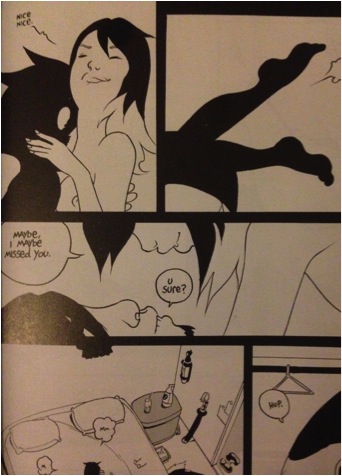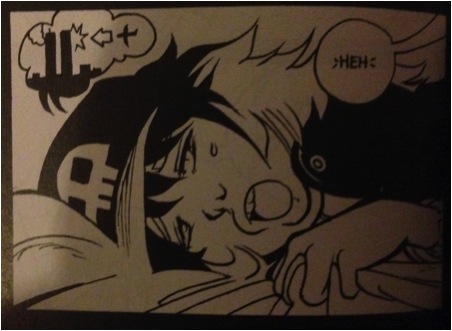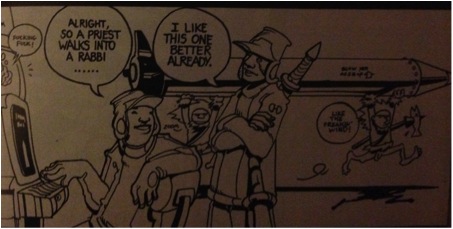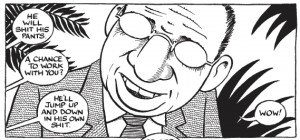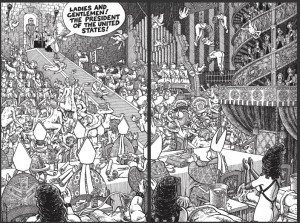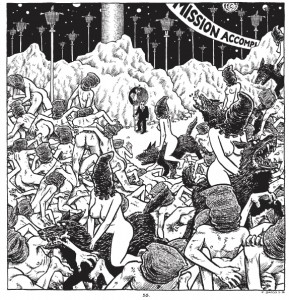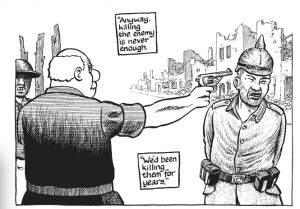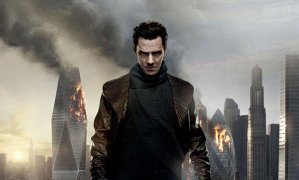(NOTE: This was first published a few years ago in the now-defunct web journal “The Fiddleback.” Noah was kind enough to let me repost it here.)
At first, it’s just Laurie Anderson’s voice, looped on an Eventide sampler. A pulmonic agressive ha repeats, calling out from 1981, exhaling middle-C. The ha continues through the duration of the song. Seven hundred one times at a pace of eighty-four beats per minute. For those of you keeping score at home, that’s a little bit over eight minutes. And yet this song, with its curious title, “O Superman,” and cold, borderline-cheesy lyrics and seemingly endless repetitions was, briefly, a monster hit. Up to #2 in the UK. One very bad recording of it on YouTube boasts that “this is what we all used to dance to back in the day.”
There are few other sonic elements introduced over the song’s eight-minute-plus length. There’s a handful of synthesized string lines and some organ. The faint sound of birds once or twice. And there’s Anderson’s vocals, a robot chorus announcing a new age.
Anderson’s work as a performance artist and musician relies heavily on distortions of her alto voice. She pitch-shifts it down two octaves, becoming a male “Voice of Authority,” or adds reverb and delay effects to punch home emotional beats. In both United States I-IV—the four hour stage show where “O Superman” debuted—and Big Science—the commercial album it appears on—Anderson sings through the vocoder, a kind of synthesizer that attaches your voice to notes you play through an instrument. You’ve heard it used by Peter Frampton on his biggest hits, or by Afrikaa Bombaata. The British also used it during World War II to send coded messages, breaking the sound up into multiple channels for spies to assemble later.
The opening lyrics of “O Superman” (“O Superman, O Judge, O Mom and Dad”) are a play on Le Cid’s aria “O Souverain, O Juge, O Pere.” In the opera, these words are uttered as a prayer of resignation, the hero putting his fate in God’s hands. In the Laurie Anderson song, the three O’s change meaning. First, she prays to Superman (Truth! Justice! The American Way!) but by the end she longs for Mom and Dad, and gives this longing voice in a series of vocoded ah’s: “Ah Ha Ha-Ah Ah-Ah-Ha.”
Despite Anderson dedicating the song to Le Cid’s composer, the two biggest influences it draws from are The Normal’s “Warm Leatherette” and the Philip Glass/Robert Wilson opera Einstein on the Beach. Indeed, “O Superman” can in some ways be read as a marriage of the two, of the uniting of brows both high and low, the repetition of minimalist opera lensed through the repetition of the dance floor.
Anderson is open about the debt she owes Einstein on the Beach. In interviews from the time, she cites the show as opening up possibilities for what a stage show could be, a process that lead to United States I-IV. O Superman’s repetitive “ha” references the sung counting during Einstein’s opening, and the keyboard lines not only sound Glassian, but the actual specific organ tone is one fans of the Philip Glass Ensemble will recognize.
The relationship between “Warm Leatherette” and “O Superman” is more tenuous. Certainly “O Superman” would not have garnered Anderson chart success and a seven-album deal with Warner Brothers without The Normal’s game-changing single from three years prior. Several sawtooth waves—chords, a siren gliss and a thwap-thwap rhythm—make up the entirety of “Warm Leatherette”’s music, while Daniel Miller, The Normal’s sole member, delivers ominous couplets about sex and car crashes. The song is essentially a musical setting of the JG Ballard novel, Crash, in which a car crash awakens the novel’s narrator to the sexual possibilities inherent in the automobile and its destruction.
It’s through “Warm Leatherette” that “O Superman” accesses JG Ballard’s apocalyptic vision of techno emptiness and Cold War nuclear anxiety. “Warm Leatherette” echoes Crash’s alienated space in which everything becomes simultaneously mechanized and eroticized. “O Superman,” meanwhile, creates a space of mechanization and alienation that also contains our human responses to this alienation: paranoia, loneliness, and a kind of heartbroken yearning. No character in a Ballard novel would ever beg to be held by Mommy, as Anderson does by the end of the song.
Coming as they do out of a theatrical tradition, Anderson’s songs, even at their most abstract, tell stories. “O Superman” is no different. Here, more or less, is its story:
You sit in your apartment in New York City at night. You are alone. Perhaps this apartment is on Canal Street, nearby the Holland Tunnel. It is 1981.
You sit in your apartment in a chair rescued off the street. The day you found it, you felt grateful that no one needed this chair anymore. This is the economy of New York furniture. People lug their unused belongings to the curb: The televisions and air conditioners with yellow paper taped to them, the word WORKS written in sharpie; the chairs that look fine, but might contain bedbugs; the couches that get waterlogged while you try to round up friends to lug them up the four flights of stairs to your apartment.
Concrete Island lies open on your lap, off to your right on a stack of milk crates rests a glass of cheap wine. Your violin leans against a nearby bookshelf, desiring your fingers and the bow.
Your phone rings. You decide that you will let the answering machine get it. People own analog answering machines, with real tapes that run and run and run out in the middle of their friends’ loquacious messages.
You hear your own voice first. “Hi. I’m not home right now. But if you want to leave a message, just start talking at the sound of the tone.”
A beep. And then. “Hello? This is your mother. Are you there? Are you coming home?” You hear need in her voice, along with a drop of reproach. Perhaps she didn’t approve of your moving to a hellhole like TriBeCa to be an artist. You do not pick up the phone. You do not tell her when you are coming home.
Another beep and then a voice you do not recognize. A man’s voice. “Hello? Is anyone home?” You do not answer it; you are not in the habit of speaking to strange men on the phone in the middle of the night. Instead of hanging up, however, he speaks more. “Well you don’t know me. But I know you. And I have a message to give to you.” Uh oh. Is this a crank caller? A stalker?
He speaks again. “Here come the planes. So you better get ready. Ready to go. You can come as you are. But pay as you go.”
You’ve had it with this man’s warnings and rhymes. You pick up the phone and say into it, “Okay, but who is this really?”
When the voice replies, what he says is terrifying. “This is the hand, the hand that takes.” He repeats it. He won’t stop saying it. You imagine just a mouth, the rest of the face shrouded in shadow, rendered in grayscale, like in an old movie.
And then he says: “Here come the planes. They’re American planes. Made in America. Smoking, or non-smoking?” He babbles on about the post office, about love, justice and force. And mom.
You hang up the phone. Confronted with this warning, with this mysterious stranger, the hand that takes, perhaps America itself, what can you do? You think about the first message. Your mother. She called you. She wants you to come home.
Sitting in your apartment, stranded in the night in New York, which despite the popultion density can feel like an island bereft of human company, you want your mother.
So hold me mom, you think to yourself, in your long arms.
You are so shaken from the phone call that the vision of your mother holding you gradually changes, becoming perverse and terrifying, but as it does so, you find yourself even more comforted.
* * *
Here come the planes. They’re American planes. Made in America.
In 1981—the year of O Superman’s commercial release—Ronald Reagan broke the air-traffic controllers’ strike and expanded the US military by the equivalent of $419,397,226.33 (adjusted for inflation).
In 2010, we’ve lost great amounts of our manufacturing sector, but one area remains triumphantly intact. We still make machines of war here in America. Boeing and Lockheed Martin are still based in the United States, the former in Chicago, the latter right outside Washington, D.C. Their plants also remain in this country, in places like Witchita, Kansas, Troy, Alabama and Columbine, Colorado. The Martin F-35 Lightening II—of which the United States intends to buy 2,443 for a price tag of over three hundred billion dollars—performed its first test run in Fort Worth, Texas.
In 2001, Mohammed Atta flew a Boeing 767—manufactured in Everett Washington— into the North Tower of the World Trade Center Building.
* * *
If you haven’t guessed by now, I might as well come clean: I was obsessed with Laurie Anderson in college. I tracked down out of print monographs of her work. I attempted to sneak her into just about every paper I wrote. Laurie Anderson thus joins a long line of serial obsessions on my part. She sits right between Eddie Izzard and Charles Mee if you’re ordering it chronolgoically.
I only knew one other person who loved Laurie Anderson. He discovered her via a twenty-six CD series titled New Wave Hits Of The Eighties that he bought off of late night television when he was in high school.
Despite all of this, four months after graduating from college, on the actual day when the American Planes Made In America finally showed up, I did not think about “O Superman.” On the actual day, U2’s borderline easy-listening track “Beautiful Day” took up unshakeable residence in my skull. It’s been said often enough to become a cliché, but the eleventh of September, 2001 really was gorgeous. The sky blue and cloudless, the temperature perfect for a walk from my then-girlfriend’s office on 56th and the West Side Highway to deep into the East Teens.
The blue sky loomed ominous, the way nights dark and stormy foreshadow murder in a potboiler. If we couldn’t trust the weather to tell us how to feel, or what would happen next, what could we trust? As we walked, desperate to put our backs to Times Square or any famous piece of Manhattan real estate, occasional planes flew overhead. When this happened, our faces blanched and our clutch on each other’s hands tightened as we ducked into the shadows of a skyscraper to watch the planes streak the blue dome above us.
And in my head, Bono wailed all the while. “It’s a beautiful day, don’t let it…” Go away? Go to waste?
I discovered that I did not actually know the words to the song. As we stopped at a McDonald’s for food, bought water off a street vendor, and entered the East side, I became fixated on figuring them out, worrying the words like a loose tooth. Solving this annoyance seemed more important—or at least more manageable—than the attack itself, the questions about my DC-dwelling parents’ safety or where our nation was headed.
Unlike most Americans, I did not see what had happened to my city until many hours after the second tower fell. By then, our epic walk concluded, we sat on our friend Alison’s couch and watched the BBC. Again and again the plane flew into tower two, again and again the orange flower bloomed, again and again the towers collapsed and we jump cut to a POV shot of someone running from a wall of dust.
One of us said what became a constant refrain. It looks just like a movie. And indeed it did.
During the weeks to follow, we heard this idea everywhere. Just like a Bruckheimer film or I thought they were showing a disaster movie, until I realized it was on all the channels, or Just like Independence Day.
What we did not ask then is why. Why, at the height of our powers, had we imagined our own destruction so often that we had a ready-made database of images to compare this moment to?
Instead, we clicked our tongues in disapproval. This showed, we believed, the shallowness and alienation of our psyches. Now the time had come to end irony once and for all. We chose this interpretation instead of acknowledging how in tune with our deepest fears mass entertainment really was.
Through the nineties, when everything seemed so good that a blow job consumed media attention for years, it turned out that we both knew and feared that the clock would run out on our exceptional good fortune. The multiplex transformed into the only place to explore these premonitions of what was to come. The movies responded by doing what they do best. They thrilled us again and again, so we didn’t have to feel bad or, really, think much, about any of this.
We did not ask these kinds of questions in the aftermath because we did not have the leisure or distance or time to ask them. Instead, we asked other questions. Questions like, Who did this? And, Whose ass do we get to kick now? And—in certain circles of the left—Is it right that we kick their ass?
The first two questions we immediately answered with a nebulous body known as “the Arabs,” later refined to “Al Qaeda.” First thing we should’ve done, someone said to me at Thanksgiving dinner that year, is turn the Middle East into a parking lot. Even on that day, when we had no idea who had done this or why, we knew it must be “the Arabs.”
On her couch—which she invited us to stay on for as long as we want—Alison launched into a monologue about the Israeli-Palestinian conflict. She did not know that my girlfriend hailed from a Muslim country and I, although a Jew, am not a Zionist. The story culminated with her running into a Hasid on the street two hours after the second tower fell. “Hey man,” she recalls herself saying, “I’m with you and Israel all the way.”
She wanted to hug him, she said, but knowing the prohibitions against touching women, did not.
In that moment my mind wandered back to my girlfriend copping to a desire to bump up against Hasidic men on the subway and then claim to be menstruating. I did not mention this. Sitting next me, my girlfriend was silent. After crying until her pale skin turned a shade of red I did not think occurred in nature, she stared at the television, unblinking.
* * *
“O Superman” contains three moments of wordplay. The first comes right after Anderson mentions the planes, when she then asks, “Smoking or non-smoking?” Since we are not riding in these planes but are instead being warned about them from a mysterious voice, the phrase takes on a double meaning, becoming about corpses.
The second is when Anderson recites the Postal Creed: “Neither snow nor rain/Nor dead of night/Will stop these couriers/From the swift completion/Of their intended rounds”
Because if (once again) we are talking of airplanes, and talking of the death they bring, then the couriers become something different, and the package they are delivering is one you certainly don’t want. Nothing will stop them. A motto of American can-do becomes a motto of uncheckable military aggression.
Or, listening to the song today, dread of the unstoppable terrorist other.
Over the 2010 holidays, as the privacy (and genitals) of white people unaccustomed to legally sanctioned harassment were violated, America seemed to wake up to the absurdity of trying to stop terrorists with the pat down and the extra large zip-loc bag. If they can’t get on a plane, they’ll blow up a subway car. They are nothing if not tenacious. Neither scanner, nor banning of liquids, nor cavity search will stop them from the swift destruction of their intended targets.
The third moment of wordplay comes at the end as Anderson calls out to her mother. Like the question about smoking, the yearning for mommy’s arms gives way to a pun, of all things. “Arms,” of course, contains two meanings, one of which is enshrined in our Second Amendment.
And so, with a mournful, churchlike basso organ sound, Anderson’s mother turns from human into weapon. Her arms progress from “long” to “automatic” to “electronic” to “petrochemical” to “military” and back to “electronic.”
When Anderson sings “petrochemical,” if you turn the volume up very high and listen very closely, you will hear birds chirping.
In college, the merging of mom and machine struck me as a silly bit of early-80s “we are the robots” kitsch. I realize now how I wrong I was. I know now that the comfort found in waging war. I know that hurting others can feel like a familial embrace.
Did our desire for this comfort—the comfort of anger, the comfort of righteousness, the comfort of inflicting, rather than receiving pain—lead us so swiftly to retribution?
And what of other kinds of comfort?
I am at atheist. On 9/11, the only working phone I could find was in a Christian bookstore. I made two phone calls while the employees praise-Jesused behind me. The first was to my girlfriend to tell her I would walk to wherever she was, the second was to my mother. My father works for Congress, and was in who-knows-what federal office building that morning.
In the week that followed, everyone I knew in New York wanted to be held in some way, to be comforted. A friend called me to tell me she had been to church that morning. I laughed into the phone, finding it—and her—absurd. Like me, she was both a Jew and an Atheist. What possible business did she have in a church?
“I was walking down the street and I saw this woman outside a church, and, she just, she just looked at me, and I knew that that was where I needed to be.”
* * *
From the fall of 2001 until the Spring of 2010, I didn’t listen to “O Superman” or really anything by Laurie Anderson. It wasn’t until I left New York to drive across the country with my now-wife that I played it again. We were all gone to look for America. We were all sorts of cliches. We didn’t care.
As the curving asphalt ribbon of the Pacific Coast Highway unspooled before us, I click-wheeled over to the song. The instant I pressed play it started to rain and we sat in silence and listened to it. And it wasn’t until I got lost in the ha that I realized how long it had been since I had heard it. How did that happen? How did a totem that I carried with me, loved so hard, like it was a person, like it belonged to me, like I made it, how did I abandon this thing for so long?
Right before Anderson’s two-minute litany of different kinds of arms, I looked over at the driver’s seat, seeking approval. Now-wife displayed the face of a champion poker player. On the stereo, Anderson paraphrases the Tao Te Ching, singing, “‘Cause when love is gone, there’s always justice, and when justice is gone, there’s always force, and when force is gone, there’s always mom.” And then her voice breaks a little, and in a rare moment of humanity Anderson says, “Hi, mom.”
It felt like letting her read my diary from before we met. I wanted to be known better by this woman I would soon marry and move from New York with. I wanted to let her see the embarrassing parts that resist verbalization and need the true falsehoods of art. Part of me felt, in this moment, like all young men who like imposing their tastes on their loved ones—that somehow my self-worth was caught up in this moment in this purple Honda listening to this song.
Why had I stopped listening to O Superman? The answer seemed obvious now. After that sunny September day, her work became unbearable to me. The song contained too much of what I tried not to feel and not to recognize about the world and myself and the country in whose name horrible things were being done.
Instead, the song went into a cardboard box in a dusty attic closed off from my soul. Also in that box: a book of plays that lay, spine cracked on my windowsill collecting mysterious black and grey and green dust from September 12th through 15th. It sits on my bookshelf now, spine facing the wall, unopened, a guardian against destruction.
* * *
At the end of the song, Anderson repeats a vocodered melodic line from the beginning: “Ah Ha Ha-Ah Ah-Ah-Ha.” This time, however, she interrupts herself with a synthesized string line that once again feels like it could come out of the Philip Glass playbook.
This string figure references the vocoder melody off of the song “From The Air,” the track right before “O Superman” on Big Science.
“From the Air” is a song about a plane crashing into New York City.
Via crossfade, an honest-to-god tenor saxophone replaces the synth strings. The only instrument to appear in the song without some kind of treatment on it, it makes its realness known by being slightly out of key.
And then, at the very end, everything cuts out, giving way once again to the ever-present, omnipotent “Ha,” repeating itself solo for seventeen seconds.
If you turn the volume up very high and listen very closely, you will hear sirens in the background.
* * *
As the song ended, we feared for our lives. The storm transformed the Pacific Coast Highway into something treacherous, slick, unknowable. The next pulloff onto more trafficked streets lay tens of miles ahead of us. Did we have enough gas to make it? Would our stomachs give out amidst the twists and turns? And—most importantly—did my now-wife like the song?
“Huh. Wow.”
“It’s kinda brilliant, right?” I asked.
“Yeah. It’s also kinda unlistenable at the same time.”
Kinda brilliant, kinda unlistenable is about as close to a judgement of the aesthetic quality of “O, Superman” as I can offer.
An odd component of post-9/11 American life has been the failure of art to address the event itself. Many—including some of our greatest living artists—have tried.
Instead, we’ve had to turn back to before the smoking day to find art that resonates. Some claim that Radiohead’s Kid A is the best album ever made about 9/11, despite coming out years before. Immediately after the event, the pundits on television wanted so badly to believe in our President that they told us to reach back to Shakespeare’s Henry V to understand how a drunken spoiled brat could become a Good Christian King.
Why not, then, appropriate “O Superman”? Laurie Anderson herself remains unclear as to the inspiration of the song. She claimed in one interview that she wrote it in response to the Iran-Contra scandal, which broke over five years after the song’s improbable chart climb. Like JG Ballard claiming to have seen the flash over Hiroshima from Hong Kong, this memory is impossible, invented but right nonetheless.
Our claming of these artifacts as being “about 9/11” shows that—rather than changing everything—that day recapitulated and unleashed what lurked, buried underneath us like one of Lovecraft’s ancient Gods. As much as we said this was the day we’d never forget, it revealed how much we’d already forgotten.

